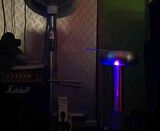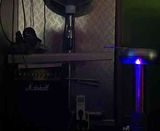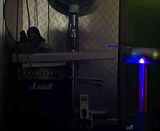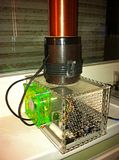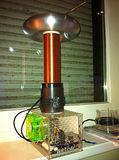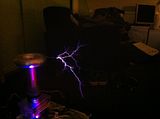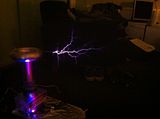Well, did some more testing.
This was my test setup.
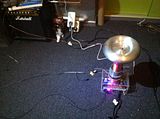

I used the scope and put the first channel probe on a quick made current transformer. I have no idea about the ratio or anything, I just care about the frequency and it does just that! The second probe was open on the ground, just like that. Can't get any easier than this.
The scope's trigger function is a takes a little getting used to. It might have something to do with the coil's natural pulsed behaviour, and that the waves of oscillations are hard to pick up for this scope, but I've managed to get in the screen by varying the second (sound frequency) knob by bits.
Some data (Have I mentioned I seem to be very bad at measuring streamer lengths?):
- Setup:
- Primary tank cap: 47 nF
- Secondary coil: 221 ohm
- Breakout: 7 cm out of topload
The frequencies were hard to determine, because if I moved a pixel, the frequency could vary by 5 kHz. I measured the secondary frequencies at the first wave
just after the primary stopped, in the ringdown.

(0% power output means that the power knob is at it's lowest setting)
Primary coil: 6,5 windings
Power setting, primary frequency, secondary frequency, est. streamer length
0%, 267 kHz, 324 kHz, 2 cm
10%, 267 kHz, 324 kHz, 2 cm
20%, 267 kHz, 327 kHz,2 cm
30%, 267 kHz, 320 kHz, 11 cm
40%, 267 kHz, 320 kHz,18 cm
50%, 267 kHz, 311 kHz, 34 cm
60%, 267 kHz, 307 kHz, 36 cm
70%, 267 kHz, 307 kHz, 32 cm
80%, 267 kHz, 307 kHz, 29 cm
90%, 267 kHz, 295 kHz, 31 cm
100%, 267 kHz, 301 kHz, 32 cm
Then I went to 7 just for trying. As expected, the primary frequency goes down.
Primary coil: 7 windings
Power setting, primary frequency, secondary frequency, est. streamer length
0%, 257 kHz, 325 kHz, 2 cm
10%, 257 kHz, 329 kHz, 2 cm
20%, 257 kHz, 337 kHz, 2.5 cm
Primary coil: 6 windings
Power setting, primary frequency, secondary frequency, est. streamer length
0%, 272 kHz, 318 kHz, 2 cm
50%, 272 kHz, 311 kHz, 30 cm
Then I tried 5 primary windings, as I figured every half winding was about 10 kHz primary frequency added. That would mean I got to about 285 or 290 kHz primary freq. Very much near the secondary frequency at the big streamer lengths...
Then I got this:

The primary is doing weird things. I've read this and that and might this be because the secondary is putting back energy in the primary? (bucking was the term?) The frequencies vary here, but the clean waves measure about 318 kHz, and the little bits in between are about 250 kHz. The coil operated fine from eyesight, however. Avarage amp draw from mains, and much bigger streamer lengths at lower power.
I noticed the same kind of behavior when I tried the large 20" streamer wire attached as in the setup picture.
*edit*
I just remembered that with the lower value tank capacitor, the primary frequency should be higher than what I'm reading...
